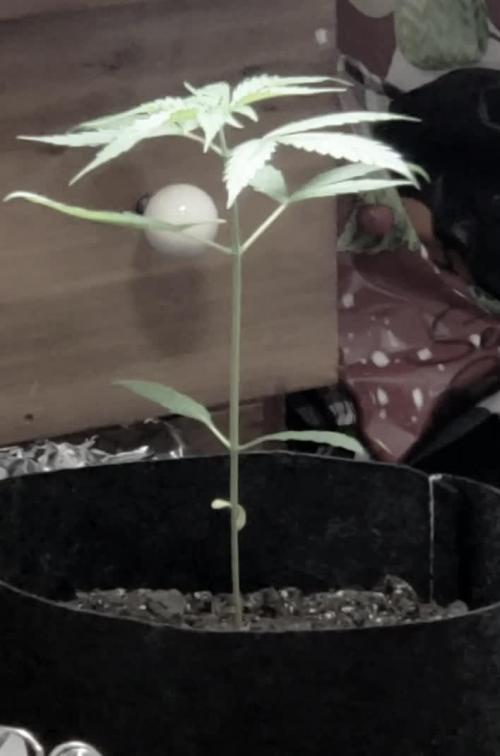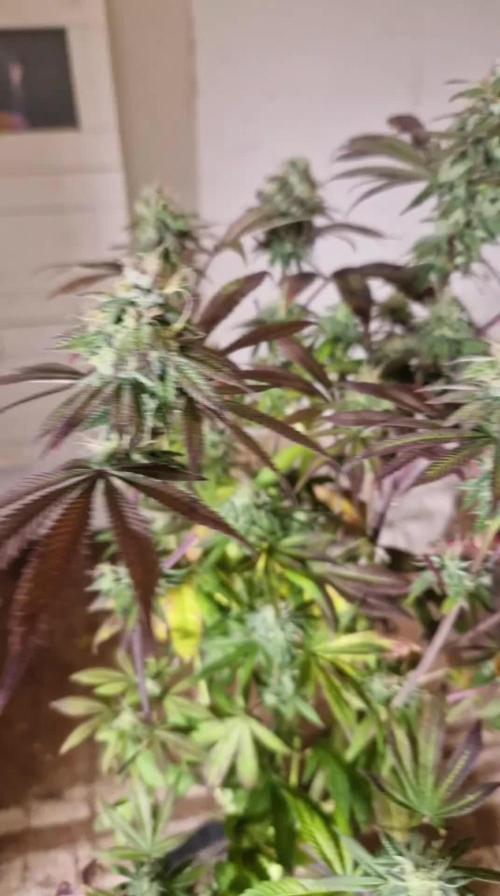The Grow Awards 2026 🏆 

































Likes
Comments
Share


@BDar_medicine
Follow
defoliating bit by bit, never sure how far to take things
day 20, this i think is the last of the defoliating, they keep getting bushy and covering lower bud sites.
okc is starting to get sticky.
Likes
8
Share


@OG_NordGrow
Follow
So Leute nach dem toppen wuchsen 3/4 normal weiter eine wirkt leicht geschockt. Wächst aber langsam weiter. Die Paya Cookies ist immer noch leicht blass. Denke das die eine gefräßige ist , versuche sie mit einer sonder Behandlung zu boosten mal schauen wie sie reagiert
Likes
5
Share


@Kaya666
Follow
Last week of actual veg! I plan to stick to the same old lighting and watering schedule this week but am gonna experiment with a foliar feed of the potassium humates to see how she likes it. I figure it's better to test things like that now than in flowering. She's beginning to develop something between the nodes, though it's still too early to tell for sure if she's a girl. (It was a feminized seed so I certainly HOPE so!)
This plant has given me absolutely zero problems despite being in the most maligned soil under a weak-ass CFL bulb AND transplanted, which is supposed to be a no-no for autos. It def looks unmistakably like pot now lol so I've gotta figure out where to hide it should the landlord come in. (Legal state, illegal building). Hoping this Ona Pro Gel will be sufficient to offset the stench once she starts reeking. 😁
So my 1st attempt with the humates was a fail. I for some reason thought the pH was too high so I sprayed some white vinegar into the mix to bring it down, which it did. But then I read that you're NOT supposed to mix the two, plus I'd possibly made the solution way too strong by using online "recipes" vs. what the package said: 1 tsp per gallon water. YIKES. I'd used 0.7 grams in 2 liters the 1st time. 🤦🏻
Thankfully I only sprayed that mix on the two bottom leaves before realizing what I'd done, so I sopped it up, poured out the rest and made a more dilute mixture without the vinegar this time. I used my little 8 Fl. oz spray bottle to mist the plant from a healthy distance before her brief dark period, which is where she's at now.
Did a 2nd foliar feed the following day and she's looking just dandy! (Aside from the twisty taco leaves at the top lol). After watering, she was incredibly bloated with leaves curling downward in that tell-tale "over watered" claw. How this is possible when I water only 1x every 7 days, grow in a fabric pot, keep fans on her at all times and am using moisture control soil is beyond me, but it would appear this plant HATES water. The soil was bone dry when I watered & I even pH'ed the water this time before giving her a drink.... no luck. Oh, and the H2O is room temperature every time. Same 16.9 FL oz. purified drinking water as last time...
After some reading it looks like this strain is just highly finicky and somewhat harder to grow than other autos, though most people ended up happy with the results. This also explains why she's so tall with so few leaves/branches: they say Zkittlez Auto stretches like crazy. I'm gonna try to stop obsessing now.
I added a 2nd CFL bulb (yellow) to see if it boosted her growth any, and sure enough, I got some noticeable and rapid change in her appearance after only one night. So that was a good thing. Next week will be when I switch to 20/4 light schedule and try a soil feed of the Potassium Humates with her once-weekly watering lol. Stay tuned.
Final update for the week: I put pipe cleaners on the ends of her big branches to help open up the bud sites. It's too late for actual LST, plus she's so sensitive I doubt she'd like it. Don't wanna waste 1-3 days recovering from that. But I'll probably lop off 2, if not 4, leaves early next week. (1-2 sets total). She's not leafy enough to "leaf tuck" as planned but some of those bottom ones are def redundant.
Likes
30
Share


@GoodBudz
Follow
It started off looking like a good week and then things turned and I was having major issues starting to show near the end of the week!!
I could tell that lowering the PPM was a good thing and was showing some signs of improvement. Things were not as crispy and
I was keeping up with the Nute, Water, Water feed with lowered PPM to around 840 on the Nute feeding days. They were drinking lots this week every other day I was watering/feeding.
But near the end of the week things started to turn for the worse. The Purple Kush fan leaves were starting to turn yellow and the Cheese was starting to get crispy again. Pretty much all smells were gone at this point and the plants were just not looking alive and healthy. I was removing lots of burnt/crisp fan leaves cause they were not looking good.
I decided at this point to raise my lights as high as they could go and hope that my issues were caused by the lights being to close.
Likes
4
Share


@Ferenc
Follow
Week 10: 20/4 light schedule, 150 mp water per plant 2x, no fertilization anymore. Day 65: Next week Tueasday/beggining week 11/ we need to harvest because they will come from the council to check the house😂 Well, the previous one finished in 69 days, but I think they won't be properly ready by next week. I tried it and made me high anyways. I would give at least 2 weeks more to be done. Tomorrow I will check the trichomes with magnifying glass. They are beautiful stinky girls. Flowers are getting thicker and pistils are getting brownish. Day 66: I checked the trichomes with magnifying glass and it will be ready by next Tuesday. 7 days left with this day. They are beautiful just check in the video (Day 66).
Day 67: It is crazy the last 3 days was so hot here in London. Today was 38 degrees!!!!!! Poor plants even with ventilation it goes up to 30-31 degrees. Well, it is alright because direct ventilation goes on so they won't be cooked. 😓😛 Day 70: It is the last day when they receive water and they just get once and half of the daily intake. 2 days before harvest I will not water them. Harvest day is on Tuesday 30th of July when they are 72 days old. I have checked the trichomes all good they are matured nicely cloudy so now it is very strong. They are very stinky girls 😋 Day 71: No more water for them..... Tomorrow is harvest day!!!!!😋
Likes
Comments
Share


@Olduffybastard88
Follow
I am waiting for a overall dry weight these plants grew like trees had a big healthy stock and were easy to grow with the good genetics I had no problems with pest I have the next generation vegging already and will.make a diary for them soon as they get big enough and the cycle continues thanks guys
Likes
10
Share


@DeepRootsGrowTrees
Follow
ROYAL QUEEN CBG AUTO
ROYAL QUEEN SEEDS
Week #3 Overall June 19th-26th
Week #2 Veg
This week no issues she's growing well medical CBD grow so it's a all organic grow. Stay Growing!!
ROYAL QUEEN SEEDS
ROYAL QUEEN CBG AUTO
Likes
5
Share


@hi_bengal
Follow
Mephisto Creme de la chem Earthbox grow using buildasoil medium and amendments.
Soaked seeds in water for 18hrs and planted into earthbox. Light hanging at 24" 300 par reading. Keeping humidity between 60/80% Temps running between 75°84°
Likes
17
Share


@HIAZ_urbanbudfarmer
Follow
She is going well, topped main & secondary branches ( 2nd topping) & performed some l.s.t. training & mainline training. Thanks to Fast Buds for the cool apparel & FF seeds, my prize for being 1 of 10 winners for November diary of the month 👍
Likes
148
Share


@CrazyHorse
Follow
Hello Folks !! The penultimate week just ends today, the largest wind leaves are already turning yellow. Today is the last day she gets HydroMix and PK 13/14. I can't wait to taste it, you can easily tell by the smell what DP took the name Orange Punch from. In addition to the orange, there is an intense skunk scent :D :D :D
Thank you for all comments and likes.
I love you all, You Lovely Girls Growers 💪💪💪
Processing
Likes
10
Share


@CanadianFillmore
Follow
Start of week 5! Plants are doing great! Still some P & K deficiencies showing, but overall the bud development is phenomenal on the blueberries and is coming along nicely on the super lemon haze. I am still feeding an extra 2 liters to the Slh, this time at full dosage of part A & B, this seems to have helped with this past week (4). The blueberry are super sticky and smell amazing!
Likes
7
Share


@Maryjane23
Follow
ciao ragazzi
ho fatto i flush a inizio settimana e oggi (circa 10 gg dopo) ho raccolto la pianta
sono molto soddisfatta a sviluppato una cima centrale molto grossa e anche tutte le cime secondarie hanno lavorato bene è ricca di tricomi molto appiccicosa con un profumo dolciastro!!!
in generale l'esperimento fast Buds è andata benone siamo nell'attesa di scoprire quali varietà rappresenta questa bellissima pianta!!!🌱🌱
💡questo splendido risultato non sarebbe stato possibile senza la mia meravigliosa lampada led Viparspectra XS2000 veramente un ottimo prodotto ve la consiglio se volete dei bei rami forti adatti a sostenere le cime grosse che ottieni!!!
this well-known brand offers different solutions look at the official website https://viparspectra.eu/
or Search for it on Amazon:
Amazon US: https://amzn.to/30xSTVq
Amazon Canada: https://amzn.to/38udUVe
Viparspectra UE: bit.ly/ViparspectraUE
Viparspectra USA: bit.ly/ViparspectraUS
continuate a seguirmi 💪
lasciate un like 👍
maryjane23😛
Likes
9
Share


@Headies
Follow
So this week after I gave it under nutrients I apparently gave it too much nitrogen while having a potassium deficiency. Shiney dark leaves, So i fixed that, but some didn't bounce back, and I tried nitrogen. I think they are doing pretty good considering everything I've put them through SO FAR. lol. Nutrients are NPK Raw's total lineup, follow their instructions at first, Fastbuds adjustments as of this week.
Likes
42
Share


@GanjaReaper
Follow
This week is almost the same as last week.
Did some LST and Defoliation.
Got rid of some stuff close to the plants so now they have more space.
They started to smell so I have to buy some other plants as well like the Jasminum polyanthum,
because I don't want any complaining neighbours.
Likes
Comments
Share


@GarciaGerardo
Follow
Banana Zkittlez comienza a florar el 22/01 ramificación muy firme y asoma tricomas apenas entra en floración.
Mpk #1 y #2 presentan unos signos mas sativos creciendo el triple de su tamaño mes a mes ( empezando a querer florar )
13/02/2024
Likes
12
Share


@JerMeds
Follow
Going to try video update this week. let me know if you like it.
Day 30, Day 24, Day 17- Good growth this week. Most are budding up. They are still pretty small but happy.
I am feeding them 5-7 gallons distributed between the 10 of them every 2 days or when the coco feels like its starting to drying out.
Outside temps have come down the past week so it has been much cooler lately.
Likes
16
Share


@Diips
Follow
been quite busy, due to my birthday and a new semester, which resulted in my Orange Apricot grew too close to the light and i mistakingly turned ny lights to 100% for a few days which ended up in light burn, so i had to re-adjust my setup and raised the lights.. also threw some netting on the orange apricot glue and some lst clips in an effort to hold them down abit..
still havent got the time to remove the burned leafs, but everything else looks perfect.
ive also raised the Sweet cheese closer to the light.























